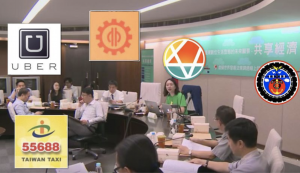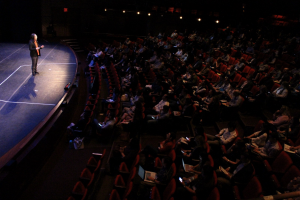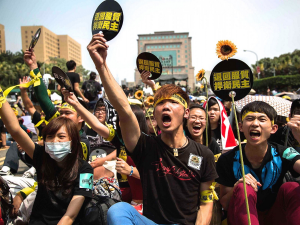A critical perspective on the cogs and performance of the vTaiwan system
Unmanned vehicles, Airbnb rentals, privacy rights, online sale of alcohol, Uber transport services – these are just some of the topics covered by the vTaiwan system since its launch in 2014. In each case, institutions of this East Asian country were able to receive the finely mapped opinions of citizens and then commit themselves to adopting the decisions on which there was the best consensus. After 4 years, where does this radical use of civic tech stand and what lessons can be drawn from experience?
Note: some of the links referenced in this article are pages in Mandarin, it is recommended that you open them using a browser offering automatic translation like Google Chrome.
The UFO that deserves your attention
What exactly does the name vTaiwan (for Virtual Taiwan) cover? It is an elaborate citizen consultation system, intersecting online participation and “enhanced” physical deliberations over time. This system, binding for the State, uses civic techs (technologies used for civic purposes) and relies on dedicated mass communication channels. It is officially and routinely part of the law-making process of Taiwanese institutions, involving thousands of citizens in varying degrees.

We must look at the cogs of this mechanism to understand how it works and differs from other digitally based civic innovations. This requires some determination, because vTaiwan is not innovating without some degree of complexity. It could be faulted for that, which may explain why it has attracted few imitators outside Asia. Nevertheless, faced with the richness of this experimentation, it is important to go deeper into its discovery. This is especially true since Taiwan is not representative of the rest of the subcontinent. It is an industrialised and high-income economy with 23 million inhabitants, more than 70% of which rely on services and whose industry is mainly based on high technology. Its GDP per capita, its indices of income equality and human development are equal to or surpass those in the European Union. This closeness merely illustrates how vital it is to understand in order to be better inspired.
When analysed, it appears that the success of the vTaiwan system is based on two unique features.
A mature context
The first relates to the social and political setting of which it is part. This brings us back to the genesis of vTaiwan. In Spring 2014, the Taiwan legislature unilaterally passes a key regulation on relations with China despite having committed to submit it to a debate involving the public. This started 22 days of occupation of parliament by Taiwanese opening it up onto the streets. Only 22 days, but during which a strong activist breeding ground demonstrated a new method of collective deliberation without an intermediary. Rigor and inventiveness enabled this agora of citizens, present as absent, to remake the law, by responding to the many reservations of the population and generating much higher support. Through the democratic efficiency of this decision-making process, then limited to retransmitted workshops and simple technological tools, the Sunflower Movement had superseded established bodies in the eyes of all. By doing so, it had returned – at least for now – the citizen to the centre of decision-making and driven out the discredited political class’s excesses of authority.

The ensuing electoral renewal led to the arrival of new figures and non-politicians in government. Among them, the minister Jaclyn Tsai, former IBM executive in charge of technology issues. She capitalised on the enthusiasm recently raised by organising a hackathon with the goal of creating a system for online policy deliberation across the country. Her promise is clear: posting all decision support resources online, a binding commitment from the government on the points of consensus identified, and answering citizens’ inquiries to the administration within 7 days. The authorities would get involved, but it would not distort the contributions. After a few weeks, the result is there and is named vTaiwan. The system garners its first achievements, leading to innovative legislative solutions and better adherence. In 2016, the new Prime Minister declares in a notice to the public authorities that all substantive issues at national level must go through a vTaiwan type process. The system would likely be extended to other levels of power in Taiwan and exported elsewhere on the continent.
Such a shift in the political paradigm in Taiwan would probably not have been possible without an underlying force ready to be mobilised. This force is the civil society of the island, which had become conscious of its own political power through the emancipation from the Kuomintang dictatorship during the 1980-1990s. However, it is possible to identify more specifically a group as a driver of change since 2014. Its name is g0v and it consists of hacktivists, activists of the citizen self-determination doubled with experienced IT developers. It is a mature community, experimenting for many years on how to support more decentralised and evidence-based decision-making (for example, with this interactive graphics on the national budget or an edit tool for ergonomic comparison tables via Google Doc). This collective made it possible to go beyond indignation to propose solutions. It also helped consolidate the gains. Following the Sunflower Movement, some g0v activists emerged on local electoral lists in 2014 – like the Indignados at the City Council of Barcelona, who also initiated a collective decision-making mechanism with Decidim Barcelona. Others were formally entrusted with defining and maintaining the processes constituting vTaiwan, as well as training civil servants. Their figurehead Audrey Tang, self-taught and an entrepreneur in the world of open-source software, is now Minister in charge of digital affairs (see her publication for Le Monde, her Ted Talk or her lecture at Super Public, the spot of the 27ème Région in Paris).

A tailored solution
The second unique feature of vTaiwan is its methodo-technological ensemble: composite, original and effective. A visit to the online platform, heart of the system, shows that the process evolves depending on the instances. The process giving the most weight to the citizen voice and that has led to real regulatory innovations comprises the following four stages:
Stage 1: Informing
As soon as possible, the audience is informed about the consultation instance as such (process and participation guidelines) and about the topics it relates to. This information, centralised on the vTaiwan platform, can for example take the form of SlideShare presentations and an adjacent discussion forum enabling their discussion. Each participant can audit the contents on the platform and edit them according to the rules of collaboration.
Stage 2: Collecting the strategic approaches
The participants position themselves on the strategic orientation of the regulation, through the Pol.is software that collects and analyses their contributions. This open source technology launched in 2014 in Seattle consists of a self-learning algorithm, a “neural network”, similar according to its co-founder Colin Megill, to “recommendation engines such as those of Netflix or Spotify, or yet to machine vision”. It takes the form of a minimalist web page, accessible via a link that can be inserted anywhere (for example: in a post shared on Facebook, in an email, on another website). On this page, the participant discovers an opinion on a topic open to consultation and can react to it (agree, disagree, neutral) or propose an alternative opinion, restricted only by the limited number of characters and the recommendation to produce only one idea per contribution. Once that’s done, a new opinion pops up, and so on. With the participation growing, the few initial opinions issued by the organisers are supplanted by the opinions of the participants themselves, which thus become the self-defined framework of the exercise. Gradually, the algorithm associates the participant with an opinion group adopting similar positions. The attitudes (responses to opinions) expressed by all the participants are aggregated continuously and automatically in a graphics display presented under the answer module. At a glance, one can find there the attitudes attracting consensus among an opinion group and those (fewer) that are consensual across all groups. It is transparent and encourages the participant –quoting the word sin participatory democracy (see Datagueule’s documentary Démocratie(s)?)– “to step back from one’s own case and reflect on the general interest of the commons”. Pol.is thus makes it possible at the same time to break down a subject into issues that are relevant to the participants, and to know their nuanced opinion on each of these aspects. In so doing, the focus is on achieving fluid consensus among different opinion groups, not on the emergence of a winning party to the detriment of others.

Stage 3: deliberating
Stakeholders are brought together in an “enhanced” meeting, framed by the results of the Pol.is module. This meeting aims to make the various stakeholders react to these results, and to begin their translation into regulation principles. The agenda is pre-published and the debate is facilitated jointly by members of the g0v community and members of government to ensure a structured and fair progression. In this exchange, the citizens’ community is represented by the principal moderator who states the conclusions drawn from the Pol.is module. In order to be accessible to the greatest number, the meeting is broadcast through live streaming, g0v activists having even begun experimenting with a 360° video (see for example this episode from Talk to Taiwan, a TV show where a government member answers questions from citizens). The streaming platform allows the audience to chat live and ask questions, some of which are submitted to the speakers. Throughout the event, the clear and paced progression and simple identification of the various speakers help to retain the attention of remote observers. The contents are then archived in video and transcribed online.

Stage 4: Observing decision-making
Follow-up of the decision-making process is made easier on the vTaiwan platform, which allows the streaming of statements by government members and deliberations of the parliamentary body, then the publication of legislative texts and official communications.
Citizen amendment
In some instances of vTaiwan, there is an extra step of co-drafting the law via citizen amendments. A “notice-and-comment” procedure is then activated on the governmental web platform join.gov.tw (similar to the Regulation Room of Cornell University). This platform allows the legislative body to publish the pre-final version of a regulation in order to collect possible amendments from the public. These amendments must be formulated within two months and must then attract enough “supporters” in order to be submitted to the legislature. The legislature subsequently has the opportunity to question the person in charge of this amendment, after which it has time to pronounce itself on the feasibility and the opportunity of integrating the proposal. Eventually it must communicate its decision through the press and on the platform, and make reference to the citizen amendment in the final legislation.
An original approach to participation
Taking a step back, one can talk of an exercise of participation broken down into two offers to citizens. They can seize one, the other, or both. The first offer is to become involved in a lighter way, incorporated into one’s daily life without this requiring any special concessions. This phase has as condition of success a fairly massive participation. This is the Pol.is module, which merely asks the citizen for a response (click on a button) or to express an opinion in one sentence (equivalent of a tweet). The module enables the seamless generation of a decision-making framework that’s legitimate, because it relies on consensus (and not on the majority) of the various opinions groups that have emerged during the exercise. This framework for the continuation of the decision-making process consists of a series of consensual strategic approaches, and an emphasis on important divergent views (strongly supported but backed by consensus) to which attention should be granted so as to create compensation. The second offer made to the participant is to get involved more heavily, at the cost of specialisation needing to be prioritised in one’s daily life. This phase – although it also calls for a diversity of points of view – has as condition of success a more reflective and complex participation. This is the module of enhanced debate and the optional amendment module, which involves a small number of participants in an in-depth discussion and the creation of technical content (accommodating applicability constraints). This makes it possible to break down the constraining strategic approaches into an applicable decision. The citizen can thus be at the centre of decision making, from the beginning to the end of the process and according to her desires and capabilities.
In this approach, vTaiwan upholds some distinctive principles: ubiquitous and centralised information of the participant, maximum transparency on all the workings of the system as well as government processes, an open expression framework that’s self-defined by and for citizens, and a focus on ergonomics or even attractiveness and playfulness (it should be “a bit like watching and playing in a IMAX 3D movie,” suggests Audrey Tang).
Promises and reality
These features have made vTaiwan an unprecedented success on the island. If we analyse it as a means to achieve better policies, we must recognise that vTaiwan has managed to reconcile different stances and overcome rigid negotiations with original solutions. If we analyse this citizen engagement as an end in itself, we can see that the most popular instances have connected thousands of people to the law-making exercise by giving them a dominant role. Yet the success of the system over these four years must be broadly nuanced.
A count performed on the platform shows that the set-up of vTaiwan described previously (including a Pol.is module) seems to have applied to less than half or even less than a quarter of the instances that were launched. There are several instances on the platform that boil down to a traditional online forum, attracting few contributions, followed by an enhanced debate. It is difficult to estimate the reason for this lack of boldness, though one can imagine a political factor. It seems in fact that the favourable institutional ground has evolved to the detriment of the citizen’s voice. The collapsing of the previous equilibrium in 2014 that put the civic movement in prominence may have been cancelled by a form of political careerism, despite the recognition given to activists. One symptom of this may be the government’s reluctance to put the regulations resulting from a vTaiwan process on the parliamentary agenda. As a result, they may remain drafts. Another indicator would be that, in all but a few cases, political authorities only solicit the population on vTaiwan for subjects strongly linked to digital innovation. The more traditional topics, with a wider socio-economic impact, have not yet been covered despite clear demands from civil society. vTaiwan thus appears to be still underused.

Nevertheless, assuming that vTaiwan is activated more often and in its most radically innovative set-up, the system itself remains imperfect. It firstly lacks accessibility to a substantial part of the population. Participation is in thousands and not yet millions of contributors. Participants are to a very large extent those with easy access to digital means and knowledge on how to use them. The least connected remain discarded, despite ongoing experiments to counter this. In addition, and as often with maturing civic techs, the processes and methodology can be unintelligible and therefore less engaging. This difficulty is further accentuated by the diversity of processes open to the public on the platform. Although it enables iteration and thereby improvement, it hinders readability. The attractiveness and democratic performance of vTaiwan could also benefit from the development of the “second offer” of participation, which is more demanding and time-consuming. One could thus imagine that the enhanced meetings also take place before the Pol.is module to ensure better information and quality of the discussions, that the module of citizen amendment be systematised, or even upstream that a self-moderated module of co-edition of legislative drafts (like the Wikipedia editorial module or the Discuto software) be established, which would serve as a base layer for the work of regulators.
A step in the right direction
By observing vTaiwan, and as with many other initiatives aimed at involving the citizen in collective choices, we can conclude that there are two success parameters. The first is the technology and the methodology that implements it. Achieving the right solution for a given population requires continuous improvement over time. This concerns the testing of software, broadcasting and algorithmic tools but also the developing of “engineering” know-how. This echoes the deployment of other elaborate solutions, such as the French-Canadian Assembl28. The second parameter, undoubtedly an even more fundamental one, is the sincere and effective participation of all players in giving the citizen primacy in the decision-making process. This may be called the culture of participation. As shown by the vTaiwan example, such a culture cannot be decreed but is woven in practice, by the building of ongoing relationships in good faith and in the long run.
In both of these two aspects, the dynamic under way in Taiwan is not perfect. But despite its current limitations and the fluctuating engagement of institutions, its resonance lies in a pioneering demonstration: it is possible to combine legitimacy, efficiency and nuance of expression in a genuine citizen framing of legislative action. Thereby vTaiwan not only gives citizens access to decision-making, but makes them the key to it.



